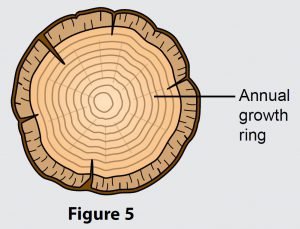Figure 5 shows a cross-section of a plant stem which lives in a temperate climate. The annual growth rings form a combination of dark and bright growth rings.

Estimate the age of the plant. Explain the formation of the annual growth rings.
(b)(i) Based on the statement below, what are the advantages of the plants that undergo secondary growth? Discuss the importance of secondary growth.
| Eudicots such as mangosteen undergo primary growth to increase its height and followed by secondary growth to increase the diameter of its stem and roots. Monocots such as grass only undergo primary growth. |
(b)(ii) Why are there only a small number of monocots that undergo secondary growth?
Explain.
Answer:
(a)
Estimated to be 9 years old.
The cambium activity is influenced by the seasons. During winter or autumn, there is low light intensity, so the vascular cambium is dormant or inactive leading to smaller secondary phloem and xylem (thick walls, darker rings). During spring or summer, the vascular cambium is active, producing larger secondary phloem and xylem (thinner walls, brighter rings).
(b)(i)
• Secondary growth provides stability to plants by increasing the stem and root diameter to suit the height of plants.
• Secondary growth provides mechanical support to plants.
• Secondary growth produces more xylem tissues and phloem tissues.
• Secondary growth produces xylem and phloem tissues continuously to replace old and damaged xylem and phloem tissues.
• Secondary growth produces stronger and thicker bark to provide protection to the plants from excessive water loss, physical injuries and disease infections.
• Secondary growth enables the plants to live longer by increasing the chances of producing seeds and reproducing.
(b)(ii)
Secondary growth does not occur in monocots because they do not have cambium tissue.
Ground tissues in monocot stems do not undergo differentation to form cortex and pith.
The timber industry in Malaysia is the biggest contributor to the commodities sector, with an export income value of RM23.2 billion in 2017. However, the income in this sector recorded a decrease in 2018 because of the lack of raw materials. Among the initiatives carried out by the government to overcome this problem is by opening acacia forest plantations. In your opinion, why is the acacia plant chosen to resolve the problem?
Answer:
The acacia is a fast-growing tree and can produce high quality wood for the pulp and paper-making industry. This hardy tree can also grow on poor soil.
The height of fruit trees need to be controlled so that they are not too tall. As a botanist, Mr. Lim suggests to his neighbour to trim the fruit trees in his orchard. Justify Mr. Lim’s suggestion based on your knowledge in biology.
Answer:
The growth of shoot apical inhibits the growth of shoot lateral. When the shoot apical is periodically cut off, this allows shoot lateral to grow actively. This can control the height of the plant.